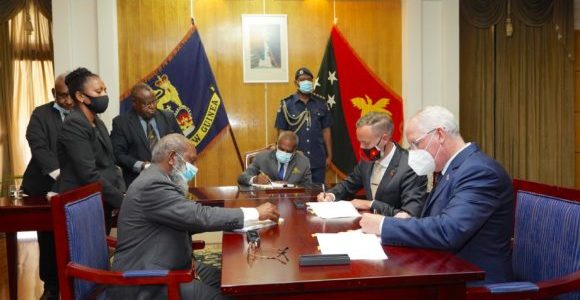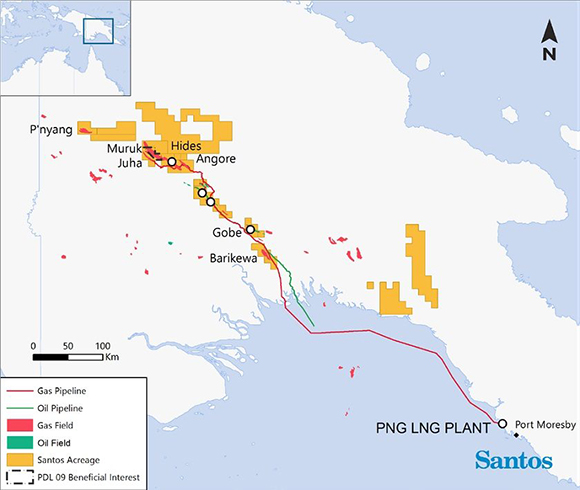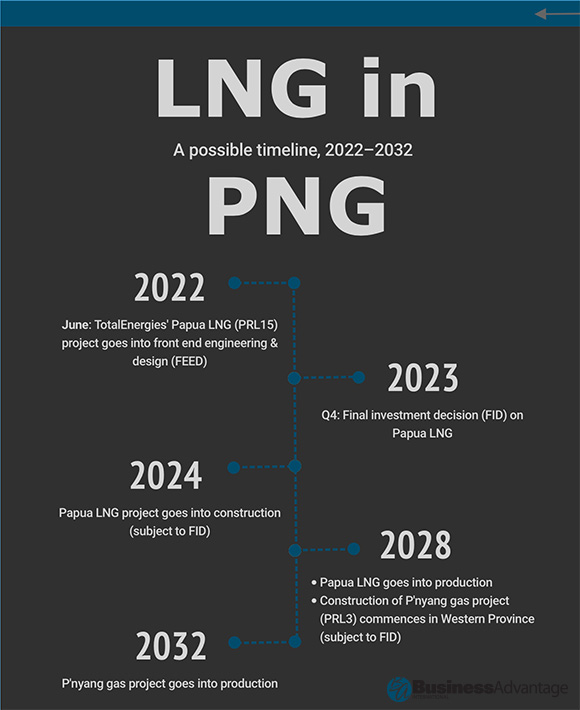With a gas agreement finally executed for the US$10 billion ExxonMobil-led P’nyang gas project, and a start date provided for front end engineering and design for TotalEnergies’ Papua LNG project, Papua New Guinea’s energy sector now has a clear roadmap for the rest of the decade. Business Advantage PNG examines what’s in store.

(l. to r.) Petroleum Minister Kerenga Kua, Governor General Sir Bob Dadae, Esso PNG P’nyang Limited’s Peter Larden and Santos’ Brett Darley signing the P’nyang Gas Agreement yesterday. Credit: ExxonMobil PNG
Last Tuesday, the PNG State executed a gas agreement with the proponents of the ExxonMobil-led P’nyang gas project, which is based on an estimated 4.36 trillion cubic feet of gas reserves within PRL3 in Papua New Guinea’s Western Province.
The deal comes after three years of on-again/off-again negotiations, during which the PNG government sought to isolate P’nyang as a stand-alone gas project, and maximise the economic benefits of the project to the State, landowners and the project’s host province.
That goal appears to have achieved in the agreement executed this week. According to the government, the gas agreement gives 34.5 per cent of the equity in the project to the PNG State, significantly more than the 22.5 per cent for the TotalEnergies-led Papua LNG project or the 19.6 per cent for PNG’s first gas project, PNG LNG. It is expected that Kumul Petroleum Holdings Ltd will be the State’s nominee for the project.
‘This provides a firm and stable economic base to the country for years to come.’
According to the Department of Prime Minister and NEC, ExxonMobil has agreed to offload 12 per cent of its stake ‘at fair market price’ to PNG parties, principally Western Province and landowners.
Currently, Exxon Mobil has a 49 percent interest in P’nyang, while Santos and JX Nippon have a 38.5 percent and 12.5 percent interest respectively.
The government has also secured a production levy of three per cent (compared to two per cent for Papua LNG) and an agreement that five per cent of the gas from P’nyang will be for domestic use.
Timeline
P’nyang is expected to commence construction following the completion of the TotalEnergies-led Papua LNG gas project, which is scheduled to commence construction in 2024 (provided a final investment decision is made, as expected, at the end of 2023).
This week, TotalEnergies confirmed Papua LNG would enter its front end engineering and design (FEED) phase in June this year.
Construction for each project would be expected to take four years, given a total construction period of eight years, during which over US$20 billion (K70 billion) would be invested in PNG by the developers.
While, in the words of Liam Mallon, President of ExxonMobil Upstream Oil and Gas, the P’nyang gas agreement is ‘a significant milestone and underscores the intent of all stakeholders to set a clear framework toward the P’nyang project’s future development,’ it is not a guarantee that the project will go ahead.
A future benefit sharing agreement must be negotiated with the State to cover benefits to landowners and a final investment decision is still to come, some time before 2028, when construction of P’nyang is planned for commencement.
Economic boost
In a statement welcoming the P’nyang agreement, PNG’s Prime Minister, James Marape, emphasised its potential economic benefits.
‘This provides a firm and stable economic base to the country for years to come: (a) construction activity from 2024 to 2032 (8 years non-stop) and revenue stream for 30 plus years thereafter,’ he said.
‘We all saw the thrust our PNG economy got during the PNG LNG construction period (2009-2014). In spite of the Global Financial Crisis, PNG’s economy experienced double digit GDP growth for the first time ever … We hope to see similar results and multiplier effects with these two LNG Projects.’
The Prime Minister said he expected PNG’s three major gas projects to deliver production and tax revenue for PNG ‘well beyond 2050′.
In a statement, Santos’ Chief Executive Officer Kevin Gallagher said the project would also ‘create local and regional jobs and business opportunities, provide training and skills development opportunities and help build stronger communities.’
Significantly, the P’nyang agreement will also assist with the viability of some smaller gas fields. P’nyang’s infrastructure can be used, under the agreement, in the exploitation of ‘stranded’ gas reserves in Western Province, Hela Province and Southern Highlands provinces. Beneficiaries of the existing PNG LNG project, which P’nyang will connect to downstream, will also collect ‘toll revenue’ from P’nyang.










Speak Your Mind